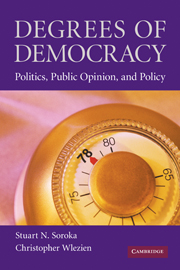Book contents
- Frontmatter
- Contents
- Preface
- Degrees of Democracy
- 1 Public Opinion and Policy in Representative Democracy
- 2 The Thermostatic Model
- 3 Adding Issues and Institutions
- 4 Public Preferences and Spending
- 5 Parameters of Public Responsiveness
- 6 Public Responsiveness Explored
- 7 Policy Representation
- 8 Disaggregating Public Responsiveness and Policy Representation
- 9 Degrees of Democracy
- Appendix
- Bibliography
- Index
4 - Public Preferences and Spending
A Preliminary Analysis
Published online by Cambridge University Press: 05 June 2012
- Frontmatter
- Contents
- Preface
- Degrees of Democracy
- 1 Public Opinion and Policy in Representative Democracy
- 2 The Thermostatic Model
- 3 Adding Issues and Institutions
- 4 Public Preferences and Spending
- 5 Parameters of Public Responsiveness
- 6 Public Responsiveness Explored
- 7 Policy Representation
- 8 Disaggregating Public Responsiveness and Policy Representation
- 9 Degrees of Democracy
- Appendix
- Bibliography
- Index
Summary
Having outlined the general thermostatic model and the structuring influences of salience and institutions, we now turn to the model's implementation – that is, the way in which we make this model empirically testable. To assess the interrelationships between policy and opinion over time, we need to examine domains where policy activity is clearly defined and occurs regularly, and where reliable time series of public preferences across a wide range of programs are available. Budgets serve these purposes very well.
All budgets register policy commitment clearly, in terms of the money actually spent on something. In addition, at the national level, budgets occur annually, providing time series of policy commitment. Although they don't tell us everything about government policies, they do tell us quite a lot; after all, almost everything the government does requires money, either as an end to itself, as for entitlement programs, or as a means to an end, as for regulation. There also are (fairly) regular surveys that sample opinion about federal spending in various categories, at least in a handful of countries – Canada, the United Kingdom and the United States. (These three countries are, as far as we know, the only countries for which there exist long-term, directly comparable time series on public preferences for spending across a range of policy domains.) These opinion data capture relative preferences for spending – whether the public wants “more” or “less” than is currently in place.
- Type
- Chapter
- Information
- Degrees of DemocracyPolitics, Public Opinion, and Policy, pp. 63 - 87Publisher: Cambridge University PressPrint publication year: 2009

